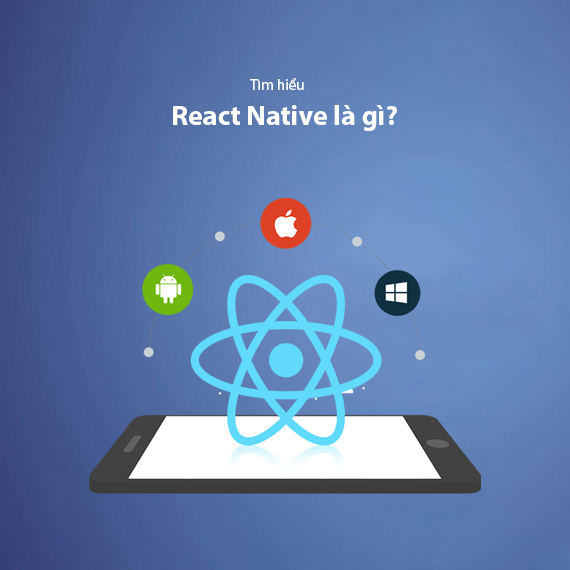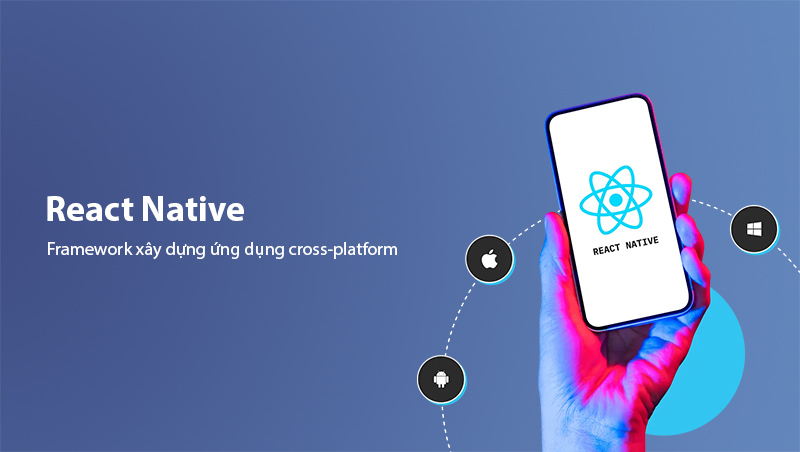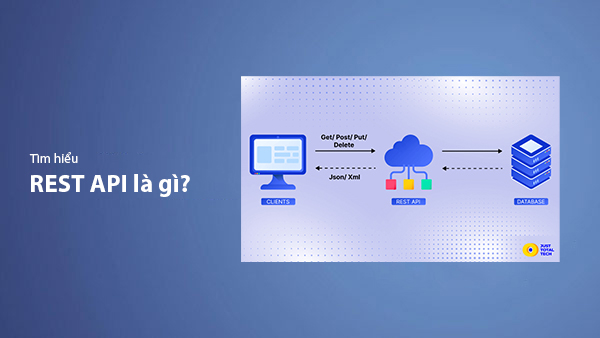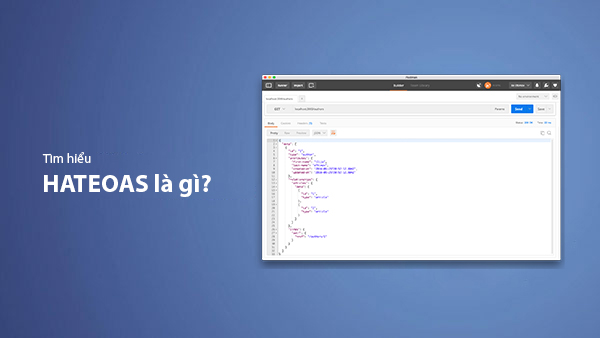Learn About React Native – A Cross-Platform Application Development Framework
- Published on

- What is React Native?
- How React Native Works
- React Native vs Hybrid App
- What is React Native?
- Advantages and Disadvantages of React Native
- Advantages:
- Disadvantages:
- Essential Knowledge for Developing React Native Apps
- JavaScript ES6+
- React.js
- JSX (JavaScript XML)
- Understanding Native Modules
- State Management
- Familiarity with Common Libraries
- Debugging and Performance Optimization
- Understanding the Mobile Ecosystem
- Practical Applications of React Native
- The Future of React Native in Mobile App Development
- Continuous Improvement from Meta (Facebook)
- The Trend of Cross-Platform Development
- Support for New Technologies
- Growing Developer Community
- Performance Optimization for Modern Devices
- Conclusion
What is React Native?
React Native is an open-source framework developed by Facebook, allowing developers to build cross-platform applications using JavaScript and the React library. With React Native, you can create applications that run on both iOS and Android from the same codebase, rather than developing separately for each platform.

One of the key advantages of this framework is that it uses native UI components instead of WebView like traditional hybrid solutions, providing performance almost equivalent to pure native applications. This makes React Native a popular choice for companies looking to develop apps quickly while maintaining high quality.
How React Native Works
React Native operates based on the combination of JavaScript and Native Modules. When developers write code using JavaScript to control application logic and define the interface using React components, the source code is converted into native UI components of the operating system via a Bridge.
Specifically, this bridge is responsible for transferring commands from JavaScript to native UI components (such as UIView on iOS and View on Android). This allows the application to respond quickly, closely resembling the performance of native apps.
The notable point is that JavaScript code runs in a separate JavaScript Thread without affecting other tasks of the application, optimizing speed and user experience. Thanks to this mechanism, React Native not only reduces the effort required to develop applications but also ensures stable performance and a sleek interface like traditional native applications.
React Native vs Hybrid App
Although React Native and hybrid applications both aim for cross-platform development, they have significant differences in terms of technology and performance.
- Hybrid Applications: Use technologies such as Cordova or Ionic, with the interface displayed within a WebView (an embedded browser inside the application). This makes hybrid applications function like a web page, which may lead to decreased performance and user experience, especially for complex graphical operations or heavy interactions.
- React Native: Does not use WebView but instead utilizes native UI components. This enables React Native-built applications to run more smoothly and provide a user experience close to that of native apps, with natural scrolling, transitions, and effects.
| Criteria | React Native | Hybrid App |
|---|---|---|
| Language Used | JavaScript and React | HTML, CSS, JavaScript |
| Operation Method | Uses a bridge to convert JavaScript into native components | Uses WebView to display the interface inside an embedded browser |
| User Interface | Native UI (native components) | WebView interface, similar to a website within the app |
| Performance | Nearly equivalent to native applications | Lower than native applications, may experience lag |
| System API Access | Good, due to the ability to directly call native modules | Limited native API access, dependent on plugins |
| Development Time | Faster due to shared codebase for both iOS and Android | Fast but requires additional optimization for native features |
| Customization | Highly customizable, close to native | Limited customization due to dependence on WebView |
| Community Support | Very large, with extensive library support | Large community but not as strong as React Native |
In summary, while hybrid applications are suitable for projects with limited budgets and simple requirements, React Native is an ideal choice for projects that need a balance between good performance and fast deployment.
What is React Native?
React Native is an open-source framework developed by Facebook that allows developers to build cross-platform applications using JavaScript and the React library. With React Native, you can create applications that run on both iOS and Android from the same codebase, instead of developing separately for each platform.

One of the main advantages of this framework is that it uses native UI components instead of WebView like traditional hybrid solutions, providing performance that is almost equivalent to pure native applications. This makes React Native a popular choice for companies that want to develop applications quickly while maintaining high quality.
To learn more about React, you can check out the article What is React?.
Advantages and Disadvantages of React Native
Advantages:
- Faster Development: Sharing the same codebase for both iOS and Android significantly reduces development time. This is ideal for projects that need to launch quickly to gain market share.
- Lower Cost: A single development team can create apps for both platforms, eliminating the need to hire separate specialists for each platform.
- Smooth and Attractive UI: Thanks to the use of native UI components, React Native apps provide a great user experience, especially with gestures, scrolling, and transitions.
- Strong Community Support: React Native has a large and active community with many libraries and plugins that speed up development.
Disadvantages:
- Performance Limitations Compared to Pure Native Apps: For apps that require complex graphical processing or heavy tasks like 3D gaming, React Native may encounter performance constraints.
- Limited Support for New APIs: Sometimes, newly introduced OS features may not be immediately supported, requiring custom native modules.
- Complex Optimization: Handling unexpected errors when integrating JavaScript with native components may require advanced technical skills and experience in dealing with custom modules.
In summary, React Native is an ideal choice for projects that require fast development and good performance, but considerations should be made for projects that need high-performance optimization or extensive use of system resources.
Essential Knowledge for Developing React Native Apps
To develop applications using React Native, it is essential to have some foundational knowledge to ensure an efficient and optimized development process. Below are the key areas you should focus on:
JavaScript ES6+
React Native uses JavaScript as its primary language, so you need to be familiar with ES6+ syntax and features such as:
Arrow functionsPromisesandasync/awaitDestructuringandspread/rest operators- Managing classes, modules, and import/export
React.js
Knowledge of React.js is crucial for understanding how React Native works. Key concepts you should master include:
- Component-based architecture: Building UI from small components
- State and Props: Managing data within components
- Lifecycle methods and Hooks: Controlling data flow and events in the application
To learn more about React, you can check out the article What is React?.
JSX (JavaScript XML)
JSX is an extended syntax of JavaScript used to describe the UI in React Native. You need to understand how to write and use JSX to easily create UI structures.
Understanding Native Modules
Since React Native needs a bridge to access the native components of the operating system, understanding how to write native modules in Java/Kotlin (Android) and Objective-C/Swift (iOS) is useful for integrating specific features that are not natively supported by React Native.
State Management
For complex applications, you need to use state management tools like Redux, MobX, or Context API to ensure consistent and maintainable data flow.
Familiarity with Common Libraries
You should get familiar with essential libraries in React Native, such as:
- React Navigation: For managing navigation between screens
- Axios/Fetch API: For connecting to APIs and fetching data from servers
- AsyncStorage: For local data storage on devices
Debugging and Performance Optimization
Development often involves debugging, so you should know how to use tools like React Native Debugger, Flipper, and Chrome DevTools for quick error identification and resolution. Additionally, optimizing components like FlatList, ScrollView, and images is crucial for improving performance.
Understanding the Mobile Ecosystem
Knowledge of how mobile operating systems work, such as permissions, build processes, and publishing apps on the App Store and Google Play, will help you complete the development cycle from coding to deployment.
Equipping yourself with the knowledge above will enable you to build professional React Native applications with high performance and an excellent user experience.
Practical Applications of React Native
React Native has been trusted and used by many large companies worldwide in their products, proving the effectiveness and flexibility of this framework.
- Facebook: Facebook, the developer of React Native, uses this framework in its main app and its fanpage management app (Facebook Ads Manager).
- Instagram: Instagram uses React Native to build features such as the push notification system and the post-editing interface, which helps accelerate deployment without compromising user experience.
- Airbnb: Although Airbnb has shifted back to native development, React Native helped them in the early stages to build unified UI modules for both operating systems efficiently.
- Uber Eats: This popular food delivery app uses React Native to develop its order management interface for drivers, making system updates and maintenance easier.
React Native is also widely used in other applications such as Tesla, Shopify, and Discord, demonstrating that it is not just a solution for small projects but strong enough to meet the complex requirements of global enterprises. This explains why React Native remains one of the most popular mobile app development tools today.
The Future of React Native in Mobile App Development
React Native has solidified its position in the mobile app development space and is expected to continue growing in the future. Several trends and factors highlight its sustainability and potential:
Continuous Improvement from Meta (Facebook)
Meta (formerly Facebook) continuously invests in improving React Native. Updates focus on optimizing performance, reducing app size, and better support for new operating system versions.
The Trend of Cross-Platform Development
With the growing demand for applications that run across multiple platforms while maintaining good performance and user experience, React Native is becoming an ideal solution for businesses seeking to optimize costs and time.
Support for New Technologies
React Native is constantly updated to be compatible with new technologies such as React Hooks, TypeScript, and backend tools like GraphQL. This allows developers to build complex applications while keeping the codebase clean and maintainable.
Growing Developer Community
The React Native community not only provides a wide range of support libraries but also actively contributes to the framework’s improvement. This ensures that bugs are fixed quickly and new technologies are integrated faster.
Performance Optimization for Modern Devices
React Native continues to improve to take full advantage of modern mobile devices' performance, such as ARM chips, powerful GPUs, and high-refresh-rate displays.
In the context of mobile app technology that increasingly demands cross-platform capabilities and performance, React Native remains a top choice for developers due to its balance between fast development and high-end user experience. This confirms that React Native will play an important role in mobile app development in the coming years.
Conclusion
React Native is a powerful solution in the cross-platform development space, enabling developers to create mobile applications quickly, efficiently, and cost-effectively while ensuring good performance. By using JavaScript and native UI components, this framework offers an experience close to that of native apps, making it suitable for various projects from small to large-scale.
However, choosing React Native should depend on the specific needs of the project. If the application requires complex graphical processing or extensive use of native APIs, pure native development remains the optimal solution. On the other hand, if the goal is rapid development and deployment on multiple platforms with reasonable costs, React Native is an ideal choice.
With strong community support and continuous investment from Meta, React Native is expected to continue playing a key role in the mobile app development ecosystem. Staying up-to-date with new trends and fully leveraging the potential of React Native will help businesses quickly build high-quality products that meet diverse market demands.
Latest Posts

Lesson 26. How to Use break, continue, and return in Java | Learn Java Basics
A guide on how to use break, continue, and return statements in Java to control loops and program execution flow effectively.

Lesson 25. The do-while Loop in Java | Learn Basic Java
A detailed guide on the do-while loop in Java, including syntax, usage, examples, and comparison with the while loop.

Lesson 24. How to Convert Decimal to Binary in Java | Learn Basic Java
A guide on how to convert numbers from the decimal system to the binary system in Java using different methods, with illustrative examples.

Lesson 23. How to Use the While Loop in Java | Learn Java Basics
Learn how to use the while loop in Java with syntax, real-world examples, and practical applications in Java programming.
Related Posts

What is REST API? Complete A-Z Knowledge About REST API
REST API is one of the essential concepts that every backend developer needs to fully understand. This article provides comprehensive knowledge about REST API, including its definition, principles of operation, and how to build a standard RESTful API.

What is HATEOAS? How to Build APIs Using HATEOAS
Learn about HATEOAS, an important concept in API development, and how to build APIs using HATEOAS to improve interactivity and scalability.

What Is GraphQL? The Advantages of GraphQL Over REST API
Explore GraphQL, a modern API technology, and why it outperforms REST API in many web development scenarios.

What is XSS? Signs of Detection and Effective Prevention Methods
Learn about XSS, signs of detection, and effective prevention methods for XSS attacks in websites.

